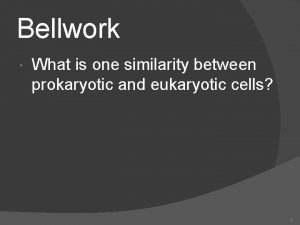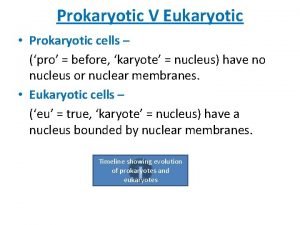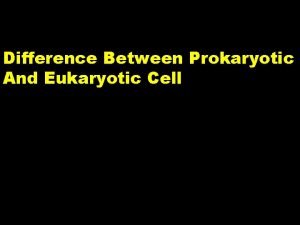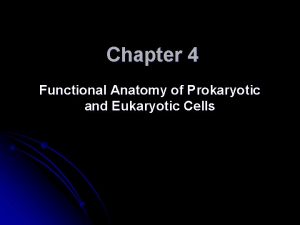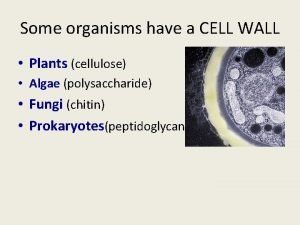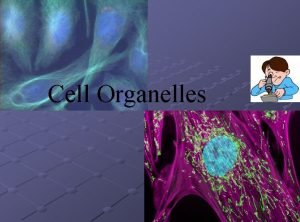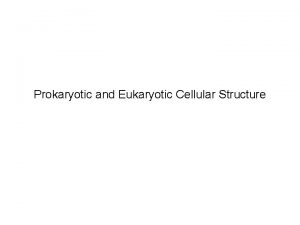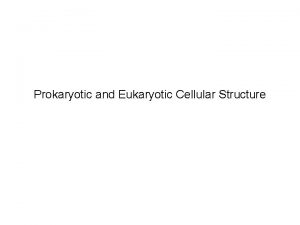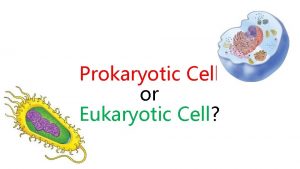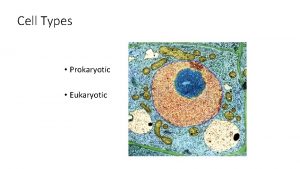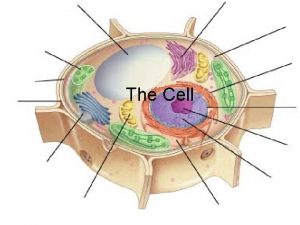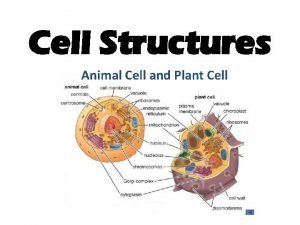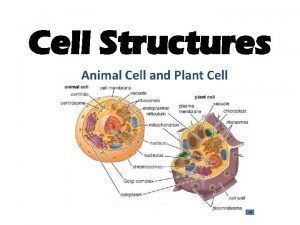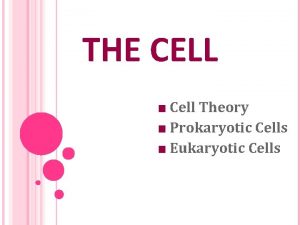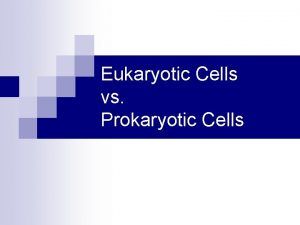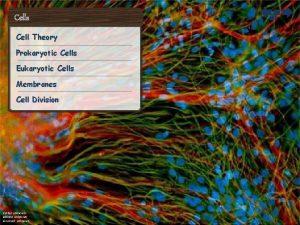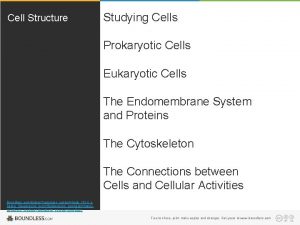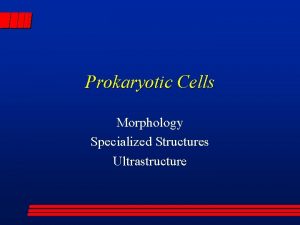Cell Structures I Prokaryotic vs Eukaryotic Cells CELLS



















- Slides: 19

Cell Structures

I. Prokaryotic vs. Eukaryotic Cells CELLS Prokaryotic Smaller • No True Nucleus - Genetic material is free-floating in cytoplasm. • No specialized organelles *except ribosomes EX: Bacteria Eukaryotic Larger • True Nucleus - Genetic material is bound by a membrane • Contain specialized organelles EX: Human Cells


Animal Cell

Plant Cell wall

II. Cell Structures & Organelles (Structure inside the cytoplasm) Structure Cell Wall Function/Other Info • Support & protection • Lies outside cell membrane • Not in animal cells • In Plants, made of cellulose • Controls what enters/ leaves the Cell cell (selectively permeable) Membrane *Transport & Excretion

Structure Cytoplasm Nucleus Function/Other Info • Watery fluid between membrane and nucleus that contains organelles • Controls most cell processes • Contains hereditary information (DNA) • Dense nucleolus produces ribosomes *Regulation

Structure Ribosome Function • PROTEIN SYNTHESIS* • Transport* materials Endoplasmic throughout cell Reticulum • Rough ER has ribosomes attached (Smooth ER doesn’t)

Structure Function Golgi Body • Modifies, Packages, and Ships materials (lipids and proteins) Vacuole • Stores food, water, wastes • Large in plant cells; Small in animal cells

Structure Lysosome Centrioles Function • Contain digestive enzymes to break down food and old organelles • Animal cells only *Nutrition • Produce spindle fibers to help separate chromosomes during cell division (reproduction) • Animal cells only

Structure Chloroplast Mitochondria “Powerhouse” Function • Use energy from sunlight to make glucose & oxygen (photosynthesis) • Not in animal cells • Contains chlorophyll (green pigment) to absorb sunlight *Nutrition • Release energy from glucose to produce ATP *Aerobic Respiration

Animal Cell endoplasmic reticulum mitochondrion Golgi Body ribosomes nucleus cytoplasm lysosome vacuole cell membrane

Plant Cell endoplasmic reticulum mitochondrion Golgi Body chloroplast ribosomes nucleus cell wall cytoplasm vacuole cell membrane

III. Photosynthesis & Respiration A. Photosynthesis 1. Conversion of light energy to chemical energy stored in carbohydrates CO 2 + H 2 O Sunlight 2. Occurs in chloroplasts C 6 H 12 O 6 + O 2 (glucose)

3. Leaf Structure a. Stomates: b. Guard Cells: Cells surrounding stomates Holes in underside of that regulate rate of leaves to allow gas transpiration by exchange and transpiration opening/closing stomates (water movement up the (decrease water loss) plant and evaporation from the leaves)

B. Cellular Respiration 1. Aerobic Respiration: total breakdown of glucose with help of oxygen to produce ATP (energy) C 6 H 12 O 6 + O 2 CO 2 + H 2 O + ATP • Occurs in cytoplasm and mitochondria of cells

b. Anaerobic Respiration: partial breakdown of glucose in cytoplasm without using oxygen (less ATP produced = less efficient) • Alcoholic Fermentation: yeast & some bacteria • Lactic Acid Fermentation: muscle cells lacking oxygen (causes muscle fatigue)


 Prokaryote vs eukaryote cells
Prokaryote vs eukaryote cells Prokaryotic cell
Prokaryotic cell 4 types of eukaryotic cells
4 types of eukaryotic cells Which organisms are prokaryotes
Which organisms are prokaryotes Prokaryotic cell vs eukaryotic cell
Prokaryotic cell vs eukaryotic cell Prokaryotic and eukaryotic cells
Prokaryotic and eukaryotic cells Prokaryotic cell and eukaryotic cell
Prokaryotic cell and eukaryotic cell Three parts of cell theory
Three parts of cell theory Cytoskeletal protein
Cytoskeletal protein Similarity between prokaryotic and eukaryotic cells
Similarity between prokaryotic and eukaryotic cells Definetion of cell
Definetion of cell Prokaryotic and eukaryotic cells chart
Prokaryotic and eukaryotic cells chart Difference between prokaryotic and eukaryotic cell
Difference between prokaryotic and eukaryotic cell How water moves
How water moves Difference between prokaryotic and eukaryotic cells
Difference between prokaryotic and eukaryotic cells Functional anatomy of prokaryotic and eukaryotic cells
Functional anatomy of prokaryotic and eukaryotic cells Lipshutz bodies
Lipshutz bodies Are cell walls prokaryotic or eukaryotic
Are cell walls prokaryotic or eukaryotic Are plants multicellular eukaryotes
Are plants multicellular eukaryotes Is animal cell prokaryotic or eukaryotic
Is animal cell prokaryotic or eukaryotic









